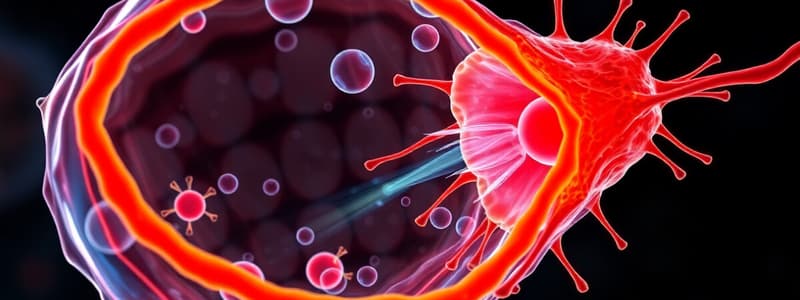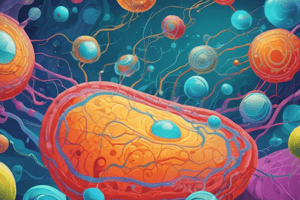Podcast
Questions and Answers
What effect does a larger mass of the diffusing substance have on its rate of diffusion?
What effect does a larger mass of the diffusing substance have on its rate of diffusion?
- It increases the rate of diffusion.
- It decreases the rate of diffusion. (correct)
- It causes diffusion to stop completely.
- It has no effect on the diffusion rate.
What is required for facilitated diffusion to occur?
What is required for facilitated diffusion to occur?
- Active transport mechanisms.
- Energy in the form of ATP.
- An increase in temperature.
- A carrier protein in the membrane. (correct)
Which of the following factors decreases the rate of diffusion?
Which of the following factors decreases the rate of diffusion?
- Shorter diffusion distance.
- Decreased concentration gradient. (correct)
- Increased surface area.
- Higher temperature.
In simple diffusion, particles move in which direction?
In simple diffusion, particles move in which direction?
What is the role of ion channels in facilitated diffusion?
What is the role of ion channels in facilitated diffusion?
What is the term for the charge difference across the plasma membrane?
What is the term for the charge difference across the plasma membrane?
Which type of transport requires energy from the cell?
Which type of transport requires energy from the cell?
What is the primary factor driving the process of diffusion?
What is the primary factor driving the process of diffusion?
What is a characteristic feature of receptor-mediated endocytosis?
What is a characteristic feature of receptor-mediated endocytosis?
Which type of passive transport specifically involves the movement of water?
Which type of passive transport specifically involves the movement of water?
What is the primary solvent in biological solutions?
What is the primary solvent in biological solutions?
Which fluid is classified as part of the extracellular fluid (ECF)?
Which fluid is classified as part of the extracellular fluid (ECF)?
How is selective permeability significant to cells?
How is selective permeability significant to cells?
What does a concentration gradient indicate?
What does a concentration gradient indicate?
Which of the following is NOT a type of transport process across cell membranes?
Which of the following is NOT a type of transport process across cell membranes?
What role does the cerebrospinal fluid play in the body?
What role does the cerebrospinal fluid play in the body?
In which of the following are solutes dissolved?
In which of the following are solutes dissolved?
Which of the following best describes an electrical gradient?
Which of the following best describes an electrical gradient?
What is released by nerve cells during the process of exocytosis?
What is released by nerve cells during the process of exocytosis?
Which of the following is a requirement for exocytosis to occur?
Which of the following is a requirement for exocytosis to occur?
In which process do vesicles move substances across a cell before releasing them?
In which process do vesicles move substances across a cell before releasing them?
Which of the following substances is typically released from the β-cells of the pancreas?
Which of the following substances is typically released from the β-cells of the pancreas?
What happens at the synaptic terminal of nerve cells?
What happens at the synaptic terminal of nerve cells?
What is the main role of exocytic vesicles during exocytosis?
What is the main role of exocytic vesicles during exocytosis?
Which type of cells are closely involved in transcytosis during pregnancy?
Which type of cells are closely involved in transcytosis during pregnancy?
What is the primary energy source required for exocytosis?
What is the primary energy source required for exocytosis?
What type of protein channel opens and closes in response to changes in membrane potential?
What type of protein channel opens and closes in response to changes in membrane potential?
What is true about carrier mediated facilitated diffusion?
What is true about carrier mediated facilitated diffusion?
Which of the following substances is NOT typically moved using carrier mediated facilitated diffusion?
Which of the following substances is NOT typically moved using carrier mediated facilitated diffusion?
How do water molecules primarily pass through the plasma membrane during osmosis?
How do water molecules primarily pass through the plasma membrane during osmosis?
What defines a gated ion channel?
What defines a gated ion channel?
Which of the following describes the process of facilitated diffusion?
Which of the following describes the process of facilitated diffusion?
What type of gated channel responds to the binding of a specific molecule?
What type of gated channel responds to the binding of a specific molecule?
Which statement about osmosis is correct?
Which statement about osmosis is correct?
What occurs after the phosphorylation of the pump protein by ATP?
What occurs after the phosphorylation of the pump protein by ATP?
What distinguishes secondary active transport from primary active transport?
What distinguishes secondary active transport from primary active transport?
Which type of endocytosis involves a specific receptor protein recognizing and binding to a particle?
Which type of endocytosis involves a specific receptor protein recognizing and binding to a particle?
What triggers the release of K+ from the pump protein?
What triggers the release of K+ from the pump protein?
What is the primary function of exocytosis?
What is the primary function of exocytosis?
What is one characteristic of phagocytosis?
What is one characteristic of phagocytosis?
Which statement is true about co-transporters (symporters)?
Which statement is true about co-transporters (symporters)?
Which of the following processes is NOT a type of endocytosis?
Which of the following processes is NOT a type of endocytosis?
Flashcards
Membrane transport
Membrane transport
The movement of substances across cell membranes, which can be passive, active, or through vesicles.
Passive transport
Passive transport
The movement of substances across cell membranes without requiring cellular energy.
Active transport
Active transport
The movement of substances across cell membranes against their concentration gradient, requiring cellular energy.
Vesicular transport
Vesicular transport
Signup and view all the flashcards
Concentration gradient
Concentration gradient
Signup and view all the flashcards
Selective permeability
Selective permeability
Signup and view all the flashcards
Intracellular fluid (ICF)
Intracellular fluid (ICF)
Signup and view all the flashcards
Extracellular fluid (ECF)
Extracellular fluid (ECF)
Signup and view all the flashcards
Membrane potential
Membrane potential
Signup and view all the flashcards
Electrochemical gradient
Electrochemical gradient
Signup and view all the flashcards
Diffusion
Diffusion
Signup and view all the flashcards
Simple Diffusion
Simple Diffusion
Signup and view all the flashcards
Facilitated Diffusion
Facilitated Diffusion
Signup and view all the flashcards
Ion Channels
Ion Channels
Signup and view all the flashcards
Protein Transporters
Protein Transporters
Signup and view all the flashcards
Ligand-Gated Channel
Ligand-Gated Channel
Signup and view all the flashcards
Voltage-Gated Channel
Voltage-Gated Channel
Signup and view all the flashcards
Mechanically-Gated Channel
Mechanically-Gated Channel
Signup and view all the flashcards
Carrier-Mediated Facilitated Diffusion
Carrier-Mediated Facilitated Diffusion
Signup and view all the flashcards
Transport Maximum
Transport Maximum
Signup and view all the flashcards
Osmosis
Osmosis
Signup and view all the flashcards
Aquaporins
Aquaporins
Signup and view all the flashcards
Primary active transport
Primary active transport
Signup and view all the flashcards
Pump protein
Pump protein
Signup and view all the flashcards
Endocytosis
Endocytosis
Signup and view all the flashcards
Exocytosis
Exocytosis
Signup and view all the flashcards
Receptor-mediated endocytosis
Receptor-mediated endocytosis
Signup and view all the flashcards
Pinocytosis
Pinocytosis
Signup and view all the flashcards
Phagocytosis
Phagocytosis
Signup and view all the flashcards
Secondary active transport
Secondary active transport
Signup and view all the flashcards
Neurotransmission
Neurotransmission
Signup and view all the flashcards
Exocytosis in Presynaptic Neuron
Exocytosis in Presynaptic Neuron
Signup and view all the flashcards
Transcytosis
Transcytosis
Signup and view all the flashcards
Study Notes
MPharm Programme - Cell Science - Cellular Process 1 & 2
- The lecture covers different transport processes across cell membranes
- Passive processes include simple diffusion, facilitated diffusion, and osmosis
- Active processes involve the use of energy to move molecules against concentration gradients
- Active processes include primary (direct ATP use) and secondary (using electrochemical gradients) active transport
- Endocytosis involves the movement of large molecules into the cell
- Types of endocytosis include phagocytosis, fluid endocytosis (pinocytosis), and receptor-mediated endocytosis
- Exocytosis involves the movement of large molecules out of the cell
- The learning objectives include understanding and explaining different transport processes, how substances are transported across membranes, examples of transport processes in cells, and their application to the nervous system and neurotransmission
- Terminology includes intracellular fluid (ICF), extracellular fluid (ECF), interstitial fluid, plasma, lymph, cerebrospinal fluid, solvent, solute, and concentration gradient
- Factors influencing diffusion include steepness of concentration gradient, temperature, mass of the substance, surface area, and distance
- The electrochemical gradient combines concentration gradient and electrical gradient to affect movement of ions across membranes.
- Simple diffusion depends on lipid solubility
- Facilitated diffusion involves a carrier protein but not ATP and moves solute down its concentration gradient
- Ion channels can be ligand or voltage gated.
- Facilitated diffusion involves channel-mediated and carrier-mediated processes.
- Example of substances transported through facilitated diffusion through carriers include glucose, fructose, and galactose.
- Osmosis is a special form of diffusion, specifically the diffusion of water through a semi-permeable membrane. Water passes through the lipid bilayer by simple diffusion, or through proteins called aquaporins.
- Osmolarity is the total solute concentration of a solution
- Tonicity refers to the ability of a solution to change the shape or tone of cells by altering their internal water volume
- Various solutions, like isotonic, hypertonic, and hypotonic solutions, can cause different effects on cells, either shrinking, swelling, or retaining their normal size and shape due to osmosis.
- Active transport uses ATP (or an electrochemical gradient) to move molecules against a concentration gradient.
- Primary active transport uses ATP directly, while secondary active transport uses electrochemical gradients. Sodium-potassium "pumps," Calcium pumps, and Hydrogen pumps are examples.
- Secondary active transport, symporters and antiporters, move molecules along with another molecule (a substance down its concentration gradient coupled with transport of the other molecule)
- Vesicular transport involves endocytosis and exocytosis, respectively.
- Endocytosis involves phagocytosis, pinocytosis and receptor-mediated endocytosis
- Exocytosis involves release of substances through vesicles fusing with the plasma membrane, and can be important for adding new membrane components, releasing neurotransmitters, or secreting hormones
- Transcytosis moves substances across cell layers, often relevant to blood vessels lining
- Key textbook readings are recommended for in-depth knowledge.
Studying That Suits You
Use AI to generate personalized quizzes and flashcards to suit your learning preferences.


